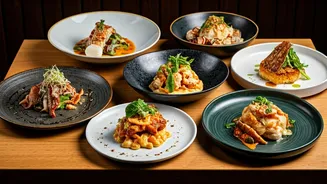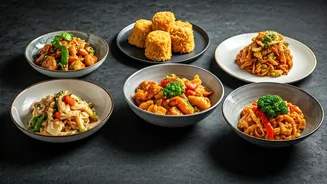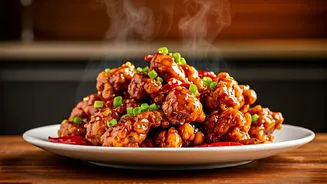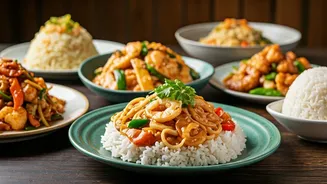Origins Unveiled
Many dishes people think of as Chinese food are actually American creations. This interesting blend of cultures has birthed new, exciting dishes that are not
authentic to China. These dishes are very well-known and liked. Let's explore some of them. These dishes evolved as Chinese immigrants adapted their cooking styles to local tastes, creating unique fusion meals. This cultural shift resulted in flavorful and widely popular meals. Many people now consider them Chinese cuisine.
General Tso's Chicken
General Tso's Chicken, with its deep-fried chicken pieces coated in a sweet and spicy sauce, is a mainstay in many Chinese restaurants globally, yet its roots aren't in China. It was created in Taiwan by Chef Peng Chang-kuei, who adapted his Hunan-style cooking to appeal to Western palates. Though the dish's flavor profile might be somewhat linked to Chinese cooking, its specific adaptation and rise in popularity occurred outside of China. The dish is a perfect example of culinary fusion.
Chop Suey Explained
Chop Suey, another well-known dish, is often considered a Chinese-American invention. Its exact origins are debated, but it's believed to have originated in the United States. Chop Suey typically includes a mix of meat (such as chicken, pork, or shrimp) and vegetables, stir-fried in a thick sauce, usually served over rice. This dish’s creation might be due to a need to use up leftover ingredients in restaurants to attract more customers. Chop Suey illustrates how Chinese food evolved when it was introduced to a new culture.
Fortune Cookie Secrets
The enigmatic Fortune Cookie, a familiar dessert at the end of many Chinese meals in the U.S., is not a Chinese creation at all. Its invention is attributed to Japanese immigrants in America during the early 20th century. These crisp, cookie-like treats, with their paper fortunes tucked inside, are a classic example of cultural adaptation. They have become an integral part of the American experience of Chinese food. Fortune cookies are rarely found in China. They exemplify how culinary traditions can be modified and adopted, creating new cultural symbols.
Orange Chicken's Story
Orange Chicken, similar to General Tso's Chicken, is a dish well-liked in Western Chinese restaurants. It's often chicken pieces that are deep-fried and covered in a sweet, tangy orange sauce. The exact beginnings are uncertain, but it's mostly a North American creation, adapted to provide a familiar and delightful eating experience. Orange Chicken showcases how restaurants change recipes to satisfy customer needs. The dish, with its sweet and zesty flavor, offers a distinctive example of food fusion.
Lo Mein Misconceptions
Lo Mein, often recognized for its soft egg noodles tossed with vegetables and meat, holds different versions when comparing China and the U.S. While the Chinese have a similar dish, the way it's prepared and the ingredients used in American Lo Mein can vary. The American adaptation tends to be sweeter and includes ingredients not commonly found in authentic Chinese versions. It demonstrates how Chinese meals change when they adapt to new locations. This shows that the original dishes have been adapted to the tastes of the American audience.















